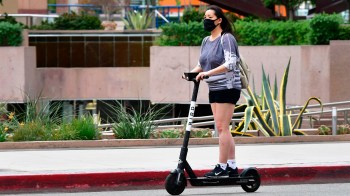
Scooters could improve mobility in low-income areas, but they have an image problem
Scooters could improve mobility in low-income areas, but they have an image problem

Cities around the country are grappling with what transportation planners call “the last mile problem”: how to get people who don’t drive from a transit stop to their final destination faster than walking. It’s an especially big issue in low-income neighborhoods where many people don’t own cars and transit service can be spotty.
Dockless electric scooters have emerged as a promising solution, but they still face several barriers to widespread adoption.
For years, Erick Huerta and his Los Angeles group, People for Mobility Justice, have been big fans of bikes as a more affordable alternative to owning a car. They have worked to expand access to public bike sharing with discount programs and community outreach. But Huerta has started to realize traditional docked bikes can only go so far.
“It’s a whole process, right?,” he said. “They have to remove a parking space. They have to install the system where you have to check it out, and the bikes and all this other stuff. So seeing where the bikes are being placed, it’s super obvious that these are touristy locations.”
In his mostly Latino East L.A. neighborhood of Boyle Heights, there are no bike-share stations. But lately, here and there, he has been seeing electric scooters, the zippy devices that have practically taken over wealthier neighborhoods at the beach, more than a dozen miles away.
“I would just think, ‘Wow, I guess somebody really took it all the way out here,'” he laughed.
Huerta and his neighbors regard the scooters with a kind of wary curiosity, like escaped zoo animals that might be dangerous.
“You associate it with tech bros and tourists, folks who aren’t from here,” he said.
In well-heeled communities, scooters have riled residents because they can be picked up and dropped off pretty much anywhere, including the middle of a sidewalk. But Regina Clewlow, the CEO of Populus, a data platform that works with cities and scooter companies to analyze how scooters are being used, said that also makes them surprisingly egalitarian.
“We are finding that newer services such as dockless bikes and scooters are being adopted at higher rates by traditionally underserved communities,” she said.
Clewlow found that in Washington, D.C., dockless devices like scooters were spread more evenly throughout low-income neighborhoods and that black residents were almost three times more likely to try them than the city’s docked bike-share system.
Like many cities, Washington, D.C., is making policies to promote dockless transportation in low-income areas. For example you can check out a scooter using pre-loaded cash instead of a credit card or unlock them using a text message rather than scanning a code with a smartphone.
| Why Uber and others see a billion-dollar future in e-scooters |
| Building an equitable bike share economy |
| When it comes to public transportation, that last mile to get home can be an issue |
Los Angeles has capped the number of scooters in most areas but allows more in disadvantaged neighborhoods. And several cities require discounted rates for people on public assistance. The scooters typically cost $1 to unlock and 15 cents per minute to use. Lime cuts that in half and Bird waives the $1 fee.
“One of the potential upsides of them for a city is that you can respond to users and make sure that they serve the communities that you’re most concerned about in a much more responsive way,” said Jacob Baskin of Coord, another data platform that tracks dockless scooters.
But forcing private companies to serve the public good is a delicate balancing act, said Susan Shaheen, a professor at the University of California, Berkeley, who studies emerging transportation tech.
“It’s going to be important that the companies aren’t so encumbered that they’re unable to start inching towards profitability, because then they may be forced to leave altogether,” she said pointing to the Chinese bike company Ofo. It was one of the early entrants into the dockless market, but it pulled out of 30 U.S. cities over the summer because, it said, local regulations undercut its business model.
Shaheen said another big obstacle for scooters is how they may be perceived.
“The image of that or the relationship of that to tech could also be a limiting factor in its appeal to low-income neighborhoods,” she said.
That’s the case for transportation activist Huerta and people in the communities where he works. As those neighborhoods gentrify, it’s almost like scooters are a physical manifestation of the forces that threaten them.
“We’ve kind of been left out in the cold for so long. So when you see these kinds of new services come in, it’s healthy to be hesitant about, well, is this for me?” he asked.
But he’s cautiously optimistic. Scooter companies have reached out to him for input, and he’s willing to give them a chance to see if they can truly help underserved neighborhoods solve the last mile problem or whether they’ll end up as just another tech fad that burns out like yesterday’s hoverboards.
There’s a lot happening in the world. Through it all, Marketplace is here for you.
You rely on Marketplace to break down the world’s events and tell you how it affects you in a fact-based, approachable way. We rely on your financial support to keep making that possible.
Your donation today powers the independent journalism that you rely on. For just $5/month, you can help sustain Marketplace so we can keep reporting on the things that matter to you.


















